#Advanced analytics in healthcare
Explore tagged Tumblr posts
Text
The Transformative Benefits of Artificial Intelligence
Title: The Transformative Benefits of Artificial Intelligence Artificial Intelligence (AI) has emerged as one of the most revolutionary technologies of the 21st century. It involves creating intelligent machines that can mimic human cognitive functions such as learning, reasoning, problem-solving, and decision-making. As AI continues to advance, its impact is felt across various industries and…

View On WordPress
#Advancements in Education#AI Advantages#AI Benefits#artificial intelligence#Customer Experience#Data Analysis#Data Analytics#Decision-Making#Efficiency and Productivity#Energy Management#Ethical AI Deployment.#Healthcare Transformation#Machine Learning#Personalized Learning#Personalized User Experiences#Robotics in Healthcare#Smart Cities#Smart Technology#Smart Traffic Management#Sustainable Development
2 notes
·
View notes
Text
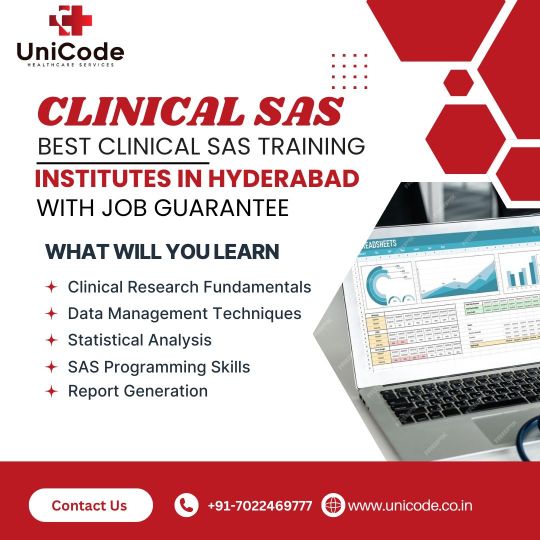
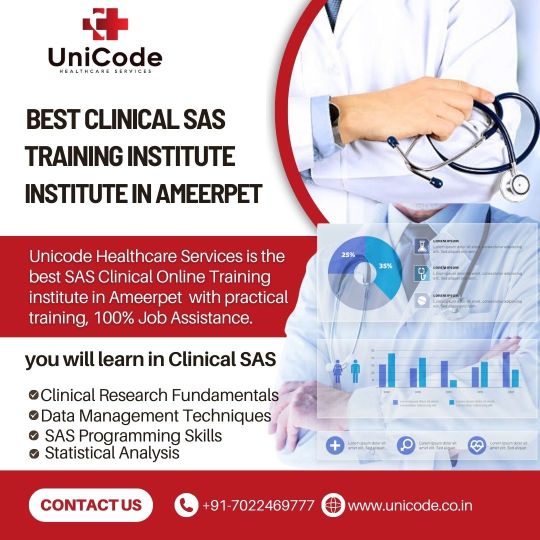
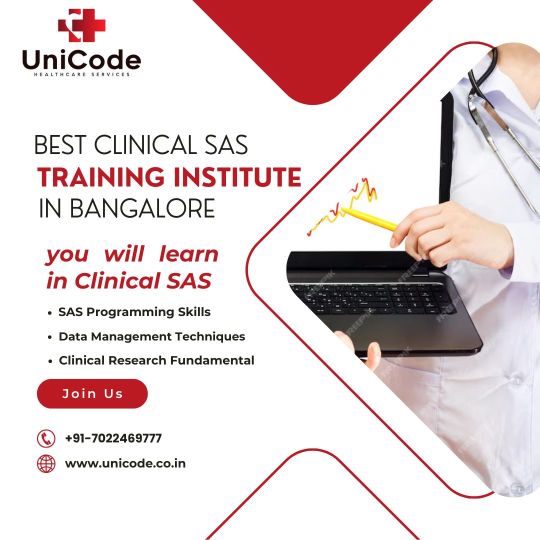
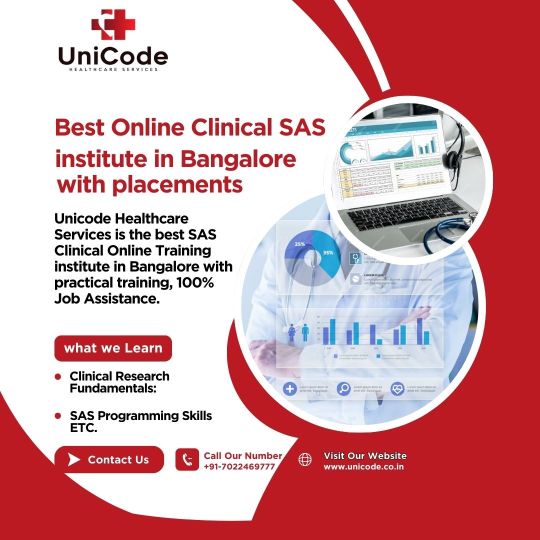
#Best Clinical SAS Training Institute in Hyderabad#Unicode Healthcare Services stands out as the top Clinical SAS training institute in Ameerpet#Hyderabad. Our comprehensive program is tailored to provide a deep understanding of Clinical SAS and its various features. The curriculum i#analytics#reporting#and graphical presentations#catering to both beginners and advanced learners.#Why Choose Unicode Healthcare Services for Clinical SAS Training?#Our team of expert instructors#with over 7 years of experience in the Pharmaceutical and Healthcare industries#ensures that students gain practical knowledge along with theoretical concepts. Using real-world examples and hands-on projects#we prepare our learners to effectively use Clinical SAS in various professional scenarios.#About Clinical SAS Training#Clinical SAS is a powerful statistical analysis system widely used in the Pharmaceutical and Healthcare industries to analyze and manage cl#and reporting.#The program includes both classroom lectures and live project work#ensuring students gain practical exposure. By completing the training#participants will be proficient in data handling#creating reports#and graphical presentations.#Course Curriculum Highlights#Our Clinical SAS course begins with the fundamentals of SAS programming#including:#Data types#variables#and expressions#Data manipulation using SAS procedures#Techniques for creating graphs and reports#Automation using SAS macros#The course also delves into advanced topics like CDISC standards
0 notes
Text
How Artificial Intelligence is Transforming Scientific Research
Introduction No one ever imagined how artificial intelligence would revolutionize scientific research. At TechtoIO, we look into how AI is not just a tool but the driver behind the rapid advancements in many scientific disciplines. That includes how science is being transformed—from better data analysis to catalyzing discovery, such as areas in health, climate science, physics, particle experimentation, and more. Read to continue link...
#Science Explained#TagsAI accelerating discoveries#AI and environmental monitoring#AI bias mitigation#AI data analysis#AI data privacy#AI future advancements#AI in astronomy#AI in climate science#AI in genomics#AI in healthcare research#AI in material science#AI in social sciences#AI in space exploration#AI medical image analysis#AI predictive analytics#AI simulations in science#AI transforming science#AI-driven drug discovery#artificial intelligence in scientific research#ethical AI in research#analysis#nvidia drive#science updates#tech news#adobe cloud#business tech#trends#science#technology
0 notes
Text
The Generative AI Revolution: Transforming Industries with Brillio
The realm of artificial intelligence is experiencing a paradigm shift with the emergence of generative AI. Unlike traditional AI models focused on analyzing existing data, generative AI takes a leap forward by creating entirely new content. The generative ai technology unlocks a future brimming with possibilities across diverse industries. Let's read about the transformative power of generative AI in various sectors:
1. Healthcare Industry:
AI for Network Optimization: Generative AI can optimize healthcare networks by predicting patient flow, resource allocation, etc. This translates to streamlined operations, improved efficiency, and potentially reduced wait times.
Generative AI for Life Sciences & Pharma: Imagine accelerating drug discovery by generating new molecule structures with desired properties. Generative AI can analyze vast datasets to identify potential drug candidates, saving valuable time and resources in the pharmaceutical research and development process.
Patient Experience Redefined: Generative AI can personalize patient communication and education. Imagine chatbots that provide tailored guidance based on a patient's medical history or generate realistic simulations for medical training.
Future of AI in Healthcare: Generative AI has the potential to revolutionize disease diagnosis and treatment plans by creating synthetic patient data for anonymized medical research and personalized drug development based on individual genetic profiles.
2. Retail Industry:
Advanced Analytics with Generative AI: Retailers can leverage generative AI to analyze customer behavior and predict future trends. This allows for targeted marketing campaigns, optimized product placement based on customer preferences, and even the generation of personalized product recommendations.
AI Retail Merchandising: Imagine creating a virtual storefront that dynamically adjusts based on customer demographics and real-time buying patterns. Generative AI can optimize product assortments, recommend complementary items, and predict optimal pricing strategies.
Demystifying Customer Experience: Generative AI can analyze customer feedback and social media data to identify emerging trends and potential areas of improvement in the customer journey. This empowers retailers to take proactive steps to enhance customer satisfaction and loyalty.

3. Finance Industry:
Generative AI in Banking: Generative AI can streamline loan application processes by automatically generating personalized loan offers and risk assessments. This reduces processing time and improves customer service efficiency.
4. Technology Industry:
Generative AI for Software Testing: Imagine automating the creation of large-scale test datasets for various software functionalities. Generative AI can expedite the testing process, identify potential vulnerabilities more effectively, and contribute to faster software releases.
Generative AI for Hi-Tech: This technology can accelerate innovation in various high-tech fields by creating novel designs for microchips, materials, or even generating code snippets to enhance existing software functionalities.
Generative AI for Telecom: Generative AI can optimize network performance by predicting potential obstruction and generating data patterns to simulate network traffic scenarios. This allows telecom companies to proactively maintain and improve network efficiency.
5. Generative AI Beyond Industries:
GenAI Powered Search Engine: Imagine a search engine that understands context and intent, generating relevant and personalized results tailored to your specific needs. This eliminates the need to sift through mountains of irrelevant information, enhancing the overall search experience.
Product Engineering with Generative AI: Design teams can leverage generative AI to create new product prototypes, explore innovative design possibilities, and accelerate the product development cycle.
Machine Learning with Generative AI: Generative AI can be used to create synthetic training data for machine learning models, leading to improved accuracy and enhanced efficiency.
Global Data Studio with Generative AI: Imagine generating realistic and anonymized datasets for data analysis purposes. This empowers researchers, businesses, and organizations to unlock insights from data while preserving privacy.
6. Learning & Development with Generative AI:
L&D Shares with Generative AI: This technology can create realistic simulations and personalized training modules tailored to individual learning styles and skill gaps. Generative AI can personalize the learning experience, fostering deeper engagement and knowledge retention.
HFS Generative AI: Generative AI can be used to personalize learning experiences for employees in the human resources and financial services sector. This technology can create tailored training programs for onboarding, compliance training, and skill development.
7. Generative AI for AIOps:
AIOps (Artificial Intelligence for IT Operations) utilizes AI to automate and optimize IT infrastructure management. Generative AI can further enhance this process by predicting potential IT issues before they occur, generating synthetic data for simulating scenarios, and optimizing remediation strategies.
Conclusion:
The potential of generative AI is vast, with its applications continuously expanding across industries. As research and development progress, we can expect even more groundbreaking advancements that will reshape the way we live, work, and interact with technology.
Reference- https://articlescad.com/the-generative-ai-revolution-transforming-industries-with-brillio-231268.html
#google generative ai services#ai for network optimization#generative ai for life sciences#generative ai in pharma#generative ai in banking#generative ai in software testing#ai technology in healthcare#future of ai in healthcare#advanced analytics in retail#ai retail merchandising#generative ai for telecom#generative ai for hi-tech#generative ai for retail#learn demystifying customer experience#generative ai for healthcare#product engineering services with Genai#accelerate application modernization#patient experience with generative ai#genai powered search engine#machine learning solution with ai#global data studio with gen ai#l&d shares with gen ai technology#hfs generative ai#generative ai for aiops
0 notes
Text
Crafting Healthcare Excellence with SaMD

In the rapidly advancing digital healthcare realm, one of the most exciting developments is the rise of Software as a Medical Device (SaMD). This innovation is revolutionizing patient care for millions worldwide, offering a more convenient and cost-effective approach to healthcare.
SaMD, as defined by the International Medical Device Regulators Forum (IMDRF), refers to software intended for medical purposes that operates on mobile phones, tablets, and computers. They aid in diagnosis, screening, monitoring, and treating various physiological conditions, covering a wide range of patient needs, from diabetes management to cloud-based solutions offering crucial insights to clinicians.
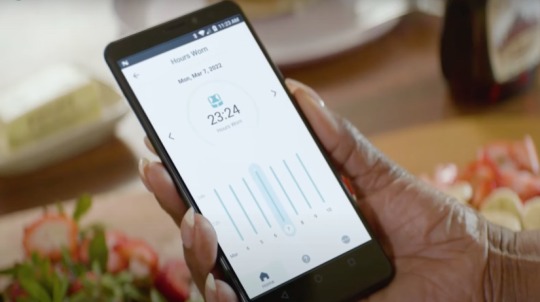
With time, there has been a significant shift in medical device functionality. SaMD applications have benefited from advancements in software engineering, enabling the integration of third-party hardware and software. This integration optimizes patient care, making it more efficient and cost-effective. Additionally, SaMD applications adhere to rigorous regulatory standards, ensuring safety and efficacy.
SaMD applications often take the form of patient engagement applications or patient companion apps that serve as the patient’s primary link and point of interaction with the medical device system. Patient companion apps have become integral in managing chronic health conditions and supporting remote patients.
For instance, diabetic patients can now effectively manage their glucose levels through integrated systems that include wearable insulin pumps, Continuous Glucose Monitors and Cloud Analytics, all accessible through a patient companion application.
As the world embraces digital healthcare, SaMD patient companion apps are increasingly becoming indispensable for companies striving to achieve their clinical and operational goals and ensure a future where healthcare is patient-centric and accessible.
Discover how GlobalLogic, a Hitachi group company, utilizes its digital engineering expertise to help Medtech companies businesses in creating Software-as-a-Medical Device (SaMD) apps
https://social-innovation.hitachi/en-us/think-ahead/healthcare/transforming-healthcare-with-software-as-a-medical-device-patient-companion-app/
#patient engagement app#patient care#remote patient monitoring#advanced healthcare analytics#healthcare innovation#cardiac care#cardiac recovery#patient app#patient experience
0 notes
Text
CT & MRI Revolution: Boosting Comorbidity Diagnosis Amid Market Demand!
In the ever-evolving landscape of medical diagnostics, computed tomography (CT) and magnetic resonance imaging (MRI) scans stand as transformative tools, reshaping physicians' abilities to tackle complex comorbidities. This blog explores the groundbreaking advancements in these imaging technologies, the escalating market demands, and how CT and MRI scans are driving excellence in medical diagnostics.
Read Full Blog Here: https://www.grgonline.com/post/ct-mri-revolution-boosting-comorbidity-diagnosis-amid-market-demand
CT and MRI Scans: The Pillars of Medical Diagnosis
CT and MRI scans have emerged as the pillars of modern medical diagnostics. These imaging technologies provide unparalleled insights into the human body, enabling physicians to identify, diagnose, and treat various medical conditions with precision.
Escalating Market Demands: The Need for Precision
In today's healthcare landscape, precision is non-negotiable. The demands for accurate and timely diagnostics are skyrocketing as comorbidities and complex medical conditions become more prevalent. CT and MRI scans are answering this call with their ability to provide detailed, three-dimensional views of internal structures.
Advancements in Imaging Technology: Beyond the Basics
The advancements in CT and MRI technology are nothing short of revolutionary. Higher resolution, faster scanning times, and the ability to capture dynamic processes within the body have elevated these scans to new heights. These innovations ensure that physicians can make diagnoses and treatment decisions with confidence.
Enhancing Diagnostic Accuracy: Unearthing Hidden Pathologies
The power of CT and MRI scans lies in their ability to unearth hidden pathologies that may go undetected through traditional diagnostic methods. These scans excel in identifying early-stage cancers, vascular abnormalities, neurological conditions, and musculoskeletal issues, among others.
Multi-Modality Approach: Comprehensive Diagnostics
CT and MRI scans are often used with other imaging modalities, providing physicians with a comprehensive diagnostic toolkit. This multi-modality approach allows for a more holistic understanding of a patient's condition, leading to tailored treatment plans.
Market Leaders: Pioneering Excellence
Market leaders in CT and MRI technology are driving excellence in medical diagnostics. These companies are at the forefront of innovation, continuously pushing the boundaries of what is possible in imaging. Their commitment to research and development ensures that physicians have access to state-of-the-art equipment.
Case Study: Early Cancer Detection
Consider a case where a patient presents with vague symptoms, and traditional tests yield inconclusive results. CT and MRI scans are employed to provide a detailed view of the patient's internal organs. The scans reveal a small tumor that would have otherwise gone undetected. Thanks to the early diagnosis facilitated by CT and MRI scans, the patient receives timely treatment and achieves a full recovery.
Conclusion: A Diagnostic Revolution
CT and MRI scans are not just diagnostic tools; they are revolutionizing how physicians approach medical diagnoses. With their precision, accuracy, and ability to uncover hidden pathologies, these scans are empowering healthcare professionals to tackle complex comorbidities with confidence. As market demands for excellence in diagnostics continue to rise, CT and MRI scans are set to play an even more pivotal role in shaping the future of healthcare.
Visit our website now: https://www.grgonline.com/
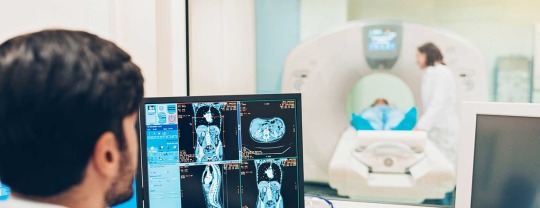
#healthcare#market demand#Diagnose With CT#medical imaging#ct scan#mri scan#diagnosis process#Diagnosis Advancements#pharmaceutical industry#data analytics#market research#marketing
0 notes
Text
Risk Adjustment, Risk Adjustment Software, Risk Adjustment Solution, Medicare health plans, Medicare Risk Adjustment Continuous healthcare quality improvement is here. TheHealthcare360™ is the company to dramatically lower the barriers of entry and the operating costs of a value-based operational model for health plans, providers, and hospital systems.

#risk adjustment software#medicare health#medicare health plans#risk adjustment#medicare software#Advanced Healthcare Analytics#Healthcare Data Analytics#Value Based Care
0 notes
Text
Career Reading
Placements to look at for your ideal career:
2nd house-how you make money
6th house-daily routine and work
10th house-career and public image
MC- career point.
11th house-social networks, long-term goals, opportunities for advancement (2nd from MC, so it shows the income from the career)
North Node - your life purpose and direction ; what you are meant to move towards in this lifetime
Part of Fortune - Where you find joy and success in this life, linked to both material and spiritual fulfillment
Vertex - represents fated encounters in your life. Where and how your destiny unfolds/ your turning point in life (not normally linked to career, but I think it can show what leads you to your true calling in this life especially if yours is in one of the money or career houses)
Saturn- rules discipline, structure, and long-term achievement, where you need to put in consistent effort to achieve success. Indicates your approach to responsibility in your career
Sun- core identity and life purpose, where you shine the most
Jupiter- expansion luck and growth. It shows your opportunities for success
Venus - where you can use your artistic abilities and social charm. It can also be how you attract money and resources
Signs and Career
Aries
• Career style: Assertive, pioneering, energetic, independent.
• Fields: Leadership roles, entrepreneurship, sports, military, anything involving action or competition.
• Drive: You take initiative and thrive in dynamic, fast-paced environments where you can be first.
Taurus
• Career style: Steady, practical, patient, and value-oriented.
• Fields: Finance, banking, agriculture, real estate, art, luxury goods, anything involving material wealth or beauty.
• Drive: Security, stability, and a focus on building long-term wealth. Aesthetic and sensory satisfaction are important.
Gemini
• Career style: Communicative, versatile, adaptable, intellectual.
• Fields: Journalism, writing, teaching, marketing, sales, technology, anything that involves communication or travel.
• Drive: Curiosity and intellectual stimulation. You thrive in dynamic, social environments where you can multitask.
Cancer
• Career style: Nurturing, protective, intuitive, emotionally driven.
• Fields: Healthcare, caregiving, real estate, hospitality, education, psychology, anything that involves caring for others.
• Drive: Emotional security and a need to create a safe, supportive environment. You work best when you feel connected to your work on an emotional level.
Leo
• Career style: Charismatic, creative, confident, leadership-focused.
• Fields: Entertainment, arts, fashion, politics, sports, anything involving self-expression and performance.
• Drive: Recognition, fame, and the desire to shine. You excel in careers where you can showcase your talents and leadership.
Virgo
• Career style: Detail-oriented, analytical, service-minded, organized.
• Fields: Healthcare, administration, research, editing, writing, data analysis, anything involving precision and service.
• Drive: Efficiency and perfection. You aim to serve others by improving systems or contributing to something meaningful.
Libra
• Career style: Diplomatic, collaborative, partnership-oriented, aesthetically inclined.
• Fields: Law, diplomacy, art, design, beauty, fashion, anything involving partnership or justice.
• Drive: Harmony and balance in professional relationships. You thrive in roles where teamwork, fairness, and aesthetics are valued.
Scorpio
• Career style: Intense, transformative, secretive, powerful.
• Fields: Psychology, research, finance (especially investments, taxes, inheritance), surgery, anything involving transformation or mystery.
• Drive: Power and control. You are drawn to careers that allow you to dig deep and uncover hidden truths or manage shared resources.
Sagittarius
• Career style: Adventurous, philosophical, expansive, freedom-loving.
• Fields: Education, travel, law, publishing, international business, anything that involves exploration and knowledge-sharing.
• Drive: Freedom and expansion. You seek opportunities that allow you to learn, grow, and explore new horizons.
Capricorn
• Career style: Ambitious, disciplined, authoritative, responsible.
• Fields: Business, politics, government, finance, engineering, management, anything that involves structure, authority, and long-term goals.
• Drive: Success and achievement. You are career-focused and work tirelessly toward building a solid reputation and legacy.
Aquarius
• Career style: Innovative, humanitarian, unconventional, forward-thinking.
• Fields: Technology, science, social reform, innovation, group work, anything involving progressive change or social impact.
• Drive: Making a difference and creating a better future. You work best in collaborative or unconventional environments that allow for innovation.
Pisces
• Career style: Compassionate, imaginative, spiritual, idealistic.
• Fields: Art, music, healing, psychology, spirituality, charity work, anything that involves creativity, intuition, or service to others.
• Drive: Helping others and finding deeper meaning. You’re drawn to careers where you can use your empathy and creativity to make a positive impact.
Houses and Career Focus
1st House (Self-Identity, Public Persona)
You identify closely with your career. You're meant for careers where you're the leader or face of whatever you do, you're meant to be in the public eye somehow.
2nd House (Money, Resources, Values)
Financial stability and security is what drives you in your career. You would do good in careers related to banking and finance or sales (more like selling luxury goods or real estate)
3rd House (Communication, Learning, Siblings)
Communication, education, and travel. Or working in media. Teaching, writing, or sales/ anything that involves exchanges of info
4th House (Home, Family, Roots)
Home design, family business, real estate. Care giving or working from home. Emotional fulfillment through your career
5th House (Creativity, Pleasure, Children)
Creative fields, working with children. Career allows for self-expression. performance or leadership roles
6th House (Work Environment, Health, Service)
Service industry, Healthcare (especially if you have heavy virgo/pisces or 6th/12th placements), administration, work that requires tedious precision and detail
7th House (Partnerships, Marriage)
Collaboration, requires partnerships in career. Law, any counseling/consulting work, diplomat
8th House (Shared Resources, Transformation)
Finance (other peoples money like taxes, inheritance, etc), psychology, research/investigation
9th House (Philosophy, Travel, Higher Education)
Higher education, travel, law, publishing, career could be linked to foreign lands, (travel vlogger, professor, resort owner?)
10th House (Career, Reputation, Public Life)
Leadership, recognition, achieving goals, public image and success are emphasized
11th House (Community, Goals, Social Networks)
Community service/humanitarian work, technology, collective work
12th House (Spirituality, Solitude, Healing)
Healing, spirituality, charity work, hospitals, or creative/behind the scenes work like set design, director etc
51 notes
·
View notes
Text

Quick sketch for Piers’ bionic arm.

Design Features
•Aesthetics: Streamlined, ergonomic design with a minimalist look, often featuring a matte or metallic finish.
•Materials: Lightweight composites like carbon fiber and titanium, providing durability without sacrificing mobility.
•Color Options: Customizable colors or finishes, including options for skin-like textures or futuristic metallics.
Technology
•Actuation: Advanced motors and actuators that enable precise, fluid movement mimicking natural limb motion.
•Sensors: Integrated sensors (e.g., myoelectric sensors) to detect muscle signals for intuitive control and movement.
•Feedback Systems: Haptic feedback mechanisms to provide users with sensory information about grip strength and object texture.
Safety and Durability
•Water and Dust Resistance: High IP ratings to protect against environmental factors.
•Emergency Features: Manual override systems or fail-safes in case of technology malfunction.
Advanced Technological Interface
•Integrated Biosensors: Built-in biosensors that can analyze blood or interstitial fluid samples to measure viral load in real time.
•Data Analytics: Utilizes algorithms to process biosensor data, providing insights on viral dynamics and trends.
•Alerts and Notifications: Real-time alerts sent to the user or healthcare provider when viral load exceeds predetermined thresholds.
•Communication System: Integrated with a communicator on the wrist, the arm serves as a reliable device for maintaining contact with his team. This system includes encrypted channels for secure communication during high-stakes operations.
•Objective Management Display: The arm features a holographic display that provides a detailed version of the communicator’s data, allowing Piers to view mission objectives and tactical data in real-time. This feature minimizes the need for external devices and keeps critical information accessible.
Augmented Reality (AR) Compatibility
•Enhanced Visualization: The arm’s display projects augmented reality overlays, allowing Piers to see additional information, such as enemy positions, weapon stats, or tactical directions, directly in his line of sight.
•Environmental Scanning: The arm can analyze the surroundings for potential threats, detect biological or chemical hazards, and provide alerts for safer navigation through hostile environments.
Electricity Conduction and Control
•Energy Conduit Design: The bionic arm acts as a conductor for the constant electrical energy generated by Piers’ mutation. It includes specialized channels and circuits designed to manage this energy flow, allowing Piers to use his mutation’s electrical pulse without it spiraling out of control.
•Dielectric Structures: The arm’s design incorporates materials that mimic the dielectric properties of his mutated tissue, particularly in the finger joints and bones. These dielectric components help regulate and contain the high voltage his body produces, diffusing excess energy safely throughout the arm.
•Controlled Release Mechanism: To avoid overload, the arm features a controlled release system that allows Piers to release pulses of energy strategically, whether in combat or to alleviate the internal buildup. This system prevents the arm from overheating or sustaining damage from prolonged electrical activity.
Containment and Compression of the Mutation
•Compression Framework: The prosthetic was specially designed by UMBRELLA engineers to act as a containment “net” around his mutation. It includes a flexible, reinforced framework that compresses the mutated tissue, keeping it in check and preventing further growth or erratic shifts in form.
•Adaptive Pressure System: As the mutation strains against the arm, sensors detect any changes in size or energy output, triggering adaptive responses. The arm tightens or loosens as necessary to hold the mutation back, functioning almost like a high-tech brace that adjusts in real-time to maintain Piers’ arm in a stable form.
•Automatic Safety Lock: In the event of a significant spike in mutation activity or electrical output, the arm engages an emergency lock to keep the mutation from expanding. This feature is a safeguard against sudden bursts of energy that could cause the arm to revert to its mutated state.
Dependency and Risks of Removal
•Rapid Mutation Onset: Without the prosthetic in place, Piers’ arm begins to mutate almost immediately, returning to its original, unstable form. The electrical pulse that his body generates becomes unrestrained, emitting a continuous, breath-like rhythm that is both painful and dangerous, with energy leaking through protruding bones and exposed tissue.
•Uncontrollable Pulse: When uncontained, the electrical pulse from his mutation surges in intensity, lacking any natural “closure” or stopping point. This pulse causes rapid fluctuations in his vital signs and risks systemic overload, leading to loss of control over his mutation and putting him at severe physical risk.
Miscellaneous Details
•The arm has a unique serial code engraved on an inner plate, serving as an identifier for UMBRELLA technicians. This code also links to Piers’ personal health records, mutation data, and arm specifications for quick access during maintenance or in emergencies.
•Due to the intense electrical pulses generated by his mutation, the arm is equipped with an internal cooling system. Micro-fans and heat-dissipating channels prevent overheating during extended use, keeping the arm at a safe, comfortable temperature. If the arm overheats, an internal alarm alerts Piers to prevent any potential damage.
•The outer layer is treated with a UV-resistant coating to protect it from environmental damage and exposure. This ensures that prolonged exposure to sunlight or harsh conditions doesn’t wear down the arm’s exterior, making it more durable in diverse climates and situations.
•Designed for various operational environments, the arm is fully waterproof and corrosion-resistant. It functions normally underwater, which is crucial for aquatic missions or when exposed to rain, mud, or corrosive substances.
•The holographic display can be customized to show additional details, such as weather, GPS navigation, or tactical maps. Piers can also set personal preferences, like color schemes or alert tones, for a more intuitive user experience. This flexibility lets him prioritize the information he finds most critical during missions.
•The communicator has an onboard language translator, enabling Piers to communicate with individuals across different languages. The arm’s display shows translated text, and a subtle earpiece can even relay audio translations, making it easier for him to gather intel and negotiate in multilingual environments.
#𝐒𝐮𝐛��𝐞𝐜𝐭 𝟏𝟑#𝐌𝐮𝐬𝐞; 𝐏𝐢𝐞𝐫𝐬 𝐍𝐢𝐯𝐚𝐧𝐬#I think I very severely fucked up my lefts and rights Ngl but oh well#resident evil#resident evil 6#piers nivans#long post
44 notes
·
View notes
Text
Week 3 Blog 9/12
How do algorithms correlate to anti-black racism?
As discussed in Nicole Brown’s “Race and Technology” Youtube video, predictive policing technology has been used in the past decade to create strategic “hit-lists” to predict who would be most likely to commit or be involved with violent crimes in the area. These innocent civilians and children with no criminal past were on high surveillance in real life, as well as their data. Anything put into their algorithms would count as incriminating evidence. Sociologist Simone Brown’s book “Dark Matters” is briefly summarized through the video. It is noteworthy to acknowledge the racial and Black surveillance themes. As technologies continue to use bias and objectification against Black communities society must create and advocate for safe and inclusive spaces within the virtual world.
How has social media proven to encourage social justice and hate at the same time?
What immediately comes to my head is the BLM movement during 2020. After the unjust arrest and murder of George Floyd, uprisings in Black communities led to protests being broadcasted. With every scroll through social media and flip through news channels we were seemingly seeing the same content with different headlines and reactions. If we circle back, the death of George Floyd itself was unfortunately a trending topic with everyone’s biased opinions rather than a call of action for an act of abuse of power. Things such as his past criminal record were brought up through the media to justify what had happened to him, others used plain excuses such as his race. The Black Lives Matter movement had already gained traction years prior due to another murder of a young Black man. Black communities weren’t feeling heard or supported and the BLM movement was once again brought to headlines to advocate for Black voices and consequences to the police force. Now as this progressed and protests made way, lootings, attacks on protests, and curfews were put into place in many areas across the country. Depending on your algorithm you probably saw an array of discourse about the matter, so much so that it had taken away from the point of what was being advocated for in the first place. WIth the freedom of speech we have the right to voice our opinions on these heavy topics surrounding social justice, but society should practice proper and respectful netiquette so we use our voices with purpose.
How much does the healthcare system really depend on technology and how are people of color affected by this?
As society progresses, so do the systems within such as healthcare. Hospitals are actually quite dependent on technology as it is now considered an essential. Some technological advancements used in the healthcare system include data and analytics, diagnostic tools, telemedicine, and electronic health records. All sounds great so how would these pose as issues to people of color? With Electronic Health Records, hospitals are able to transfer patient data for improved treatment and coordination but when it comes to patients in areas with limited digital resources they are left with outdated medical treatment. “Racial bias in a medical algorithm favors white patients over sicker black patients” headlines The Washington Post as seen on Nicole Brown’s “Race and Technology” Youtube video. So yes, the use of data, algorithms, and technology has been proven to create a progressive era for healthcare and its patients, but we as a society must be aware of how this affects minority communities due to embedded bias and properly advocate for change.
Is AI ruining the future of students?
As students are distanced from pencils and paper and moved onto digital spaces, there is a lack of creativity and critical thinking within the entire generation of students. Students are able to use Grammarly and ChatGPT to write papers. Students are able to use Photomath and Mathway to complete math problems. Students are limited to a keyboard and screen for discussions and are missing raw interactions and conversations. This is a danger to the future workforce as many students are cheating their way through schooling and depending on hands on experience without book knowledge and human networking. Many are afraid of AI becoming the future of everything and that can only happen if we continue this co-dependent relationship with it.
https://www.youtube.com/watch?v=d8uiAjigKy8
Automating Inequality Intro (Eubanks)
Rethinking Cyberfeminism (Daniels
10 notes
·
View notes
Text
How AI & Machine Learning Are Changing UI/UX Design

Artificial Intelligence (AI) and Machine Learning (ML) are revolutionizing UI/UX design by making digital experiences more intelligent, adaptive, and user-centric. From personalized interfaces to automated design processes, AI is reshaping how designers create and enhance user experiences. In this blog, we explore the key ways AI and ML are transforming UI/UX design and what the future holds.
For more UI/UX trends and insights, visit Pixelizes Blog.
AI-Driven Personalization
One of the biggest changes AI has brought to UI/UX design is hyper-personalization. By analyzing user behavior, AI can tailor content, recommendations, and layouts to individual preferences, creating a more engaging experience.
How It Works:
AI analyzes user interactions, including clicks, time spent, and preferences.
Dynamic UI adjustments ensure users see what’s most relevant to them.
Personalized recommendations, like Netflix suggesting shows or e-commerce platforms curating product lists.
Smart Chatbots & Conversational UI
AI-powered chatbots have revolutionized customer interactions by offering real-time, intelligent responses. They enhance UX by providing 24/7 support, answering FAQs, and guiding users seamlessly through applications or websites.
Examples:
Virtual assistants like Siri, Alexa, and Google Assistant.
AI chatbots in banking, e-commerce, and healthcare.
NLP-powered bots that understand user intent and sentiment.
Predictive UX: Anticipating User Needs
Predictive UX leverages ML algorithms to anticipate user actions before they happen, streamlining interactions and reducing friction.
Real-World Applications:
Smart search suggestions (e.g., Google, Amazon, Spotify).
AI-powered auto-fill forms that reduce typing effort.
Anticipatory design like Google Maps estimating destinations.
AI-Powered UI Design Automation
AI is streamlining design workflows by automating repetitive tasks, allowing designers to focus on creativity and innovation.
Key AI-Powered Tools:
Adobe Sensei: Automates image editing, tagging, and design suggestions.
Figma AI Plugins & Sketch: Generate elements based on user input.
UX Writing Assistants that enhance microcopy with NLP.
Voice & Gesture-Based Interactions
With AI advancements, voice and gesture control are becoming standard features in UI/UX design, offering more intuitive, hands-free interactions.
Examples:
Voice commands via Google Assistant, Siri, Alexa.
Gesture-based UI on smart TVs, AR/VR devices.
Facial recognition & biometric authentication for secure logins.
AI in Accessibility & Inclusive Design
AI is making digital products more accessible to users with disabilities by enabling assistive technologies and improving UX for all.
How AI Enhances Accessibility:
Voice-to-text and text-to-speech via Google Accessibility.
Alt-text generation for visually impaired users.
Automated color contrast adjustments for better readability.
Sentiment Analysis for Improved UX
AI-powered sentiment analysis tools track user emotions through feedback, reviews, and interactions, helping designers refine UX strategies.
Uses of Sentiment Analysis:
Detecting frustration points in customer feedback.
Optimizing UI elements based on emotional responses.
Enhancing A/B testing insights with AI-driven analytics.
Future of AI in UI/UX: What’s Next?
As AI and ML continue to evolve, UI/UX design will become more intuitive, adaptive, and human-centric. Future trends include:
AI-generated UI designs with minimal manual input.
Real-time, emotion-based UX adaptations.
Brain-computer interface (BCI) integrations for immersive experiences.
Final Thoughts
AI and ML are not replacing designers—they are empowering them to deliver smarter, faster, and more engaging experiences. As we move into a future dominated by intelligent interfaces, UI/UX designers must embrace AI-powered design methodologies to create more personalized, accessible, and user-friendly digital products.
Explore more at Pixelizes.com for cutting-edge design insights, AI tools, and UX trends.
#AI in UX Design#Machine Learning UX#UX Personalization#Conversational UI#Predictive UX#AI Chatbots#Smart UX Tools#UI Automation#Voice UI Design#Inclusive UX Design#Sentiment Analysis in UX#Future of UX#AI UX Trends 2025#Figma AI Plugins#Accessibility with AI#Adaptive UI Design#UX Innovation#Human-Centered AI#Pixelizes Blog#UX Strategy
2 notes
·
View notes
Text
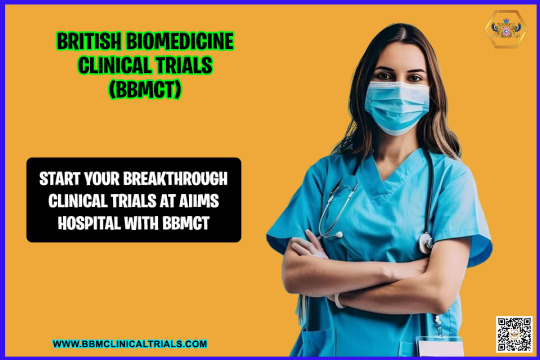
Start Your Breakthrough Clinical Trials At AIIMS Hospital With BBMCT
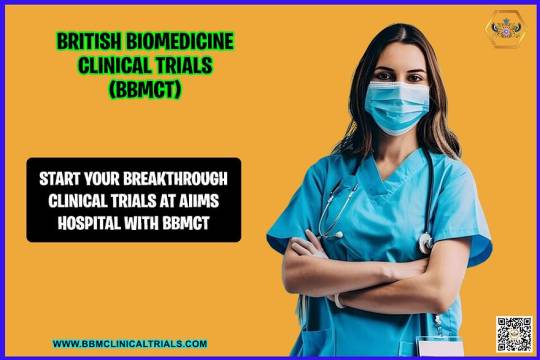
Clinical trials are the backbone of medical advancements, helping researchers and healthcare professionals find new treatments, therapies, and solutions to pressing health issues. In India, AIIMS (All India Institute of Medical Sciences) has long been at the forefront of healthcare excellence, and when combined with **British Biomedicine Clinical Trials (BBMCT)**, it offers world-class research facilities and clinical expertise for cutting-edge breakthroughs. In this article, we’ll explore how BBMCT at AIIMS provides unmatched support for clinical research and trials.
— -
### **World-Class Research Facilities Available**
AIIMS Hospital is renowned globally for its state-of-the-art research infrastructure. The research facilities at AIIMS are designed to cater to diverse medical specialties, making it an ideal location for conducting advanced clinical trials. The hospital’s vast campus houses modern laboratories, research centers, and equipment, all of which are equipped with the latest technology to support clinical research.
British Biomedicine Clinical Trials (BBMCT) leverages these facilities to create an environment where studies can progress smoothly and efficiently. Whether it’s pharmacokinetics, bioequivalence studies, or clinical pharmacology trials, BBMCT at AIIMS offers a comprehensive setup for all kinds of advanced research. This enables researchers to gather precise data, ensuring faster and more accurate results.
— -
### **Expert Clinical Trials Management Team**
The success of clinical trials depends largely on the expertise and experience of the team managing them. BBMCT at AIIMS boasts an experienced team of medical professionals, researchers, and trial coordinators who specialize in clinical research and trial management. This team oversees every aspect of the clinical trial process, from initial planning to the final data analysis.
The clinical trial management team at BBMCT follows international best practices in Good Clinical Practice (GCP), ensuring that all trials meet rigorous scientific and ethical standards. Their profound knowledge in regulatory compliance, patient safety, and data integrity is a key asset for any study looking to achieve reliable and actionable results.
— -
### **Access to Diverse Patient Populations**
A unique advantage of conducting clinical trials at AIIMS is the access to a highly diverse patient population. AIIMS caters to patients from various socio-economic backgrounds, ethnicities, and regions. This diversity enhances the generalizability and relevance of clinical trial outcomes, ensuring that findings are applicable to a broad spectrum of people.
BBMCT at AIIMS takes full advantage of this diverse patient pool, allowing researchers to study the effects of treatments on a wide range of individuals. This helps researchers to detect varying responses to interventions, ensuring that the clinical trial results are robust, representative, and suitable for global healthcare applications.
— -
### **Cutting-Edge Technology Integration Offered**
To stay ahead in the fast-paced world of clinical trials, BBMCT integrates the latest technological advancements in clinical research at AIIMS. From electronic data capture (EDC) systems to cloud-based analytics platforms, AIIMS and BBMCT are fully equipped with cutting-edge technologies that streamline trial processes and improve accuracy.
These technologies enable real-time monitoring of trial data, faster recruitment and retention of participants, and more efficient management of study documentation. Furthermore, AIIMS is constantly upgrading its infrastructure to incorporate new innovations, ensuring that trials benefit from the most advanced tools available in medical research.
— -
### **Robust Ethical Oversight Ensured Here**
Clinical trials often involve testing new treatments on human participants, making ethical oversight a critical part of the research process. At AIIMS, ethical considerations are a top priority. BBMCT ensures that all clinical trials are conducted in accordance with the highest ethical standards, including patient informed consent, confidentiality, and protection from harm.
AIIMS has a dedicated ethics committee that reviews and monitors each clinical trial to ensure compliance with national and international ethical guidelines. This oversight gives patients confidence in participating and reassures researchers that their trials are conducted responsibly, ensuring the integrity and credibility of the results.
— -
### **Collaborate With Leading Medical Experts**
When conducting clinical research at AIIMS with BBMCT, you gain access to some of the leading medical experts in various fields. AIIMS is home to renowned specialists and researchers across disciplines, including oncology, cardiology, neurology, and infectious diseases.
Collaborating with these experts not only enhances the quality of research but also allows for interdisciplinary approaches to clinical trials. BBMCT fosters an environment of collaboration, where your study can benefit from the expertise and innovative solutions provided by these thought leaders in medicine and clinical research.
— -
### **Streamlined Processes for Quick Trials**
The faster clinical trials progress, the sooner medical breakthroughs can be made. At BBMCT, the processes involved in clinical trials are streamlined to reduce unnecessary delays and inefficiencies. From patient recruitment to data collection and analysis, BBMCT ensures that every phase of the trial is executed promptly.
AIIMS’ established infrastructure and resources facilitate quick approvals, recruitment, and trial management, meaning that studies can progress without the common bottlenecks seen in other settings. This streamlined approach is critical in accelerating the development of new treatments and improving patient outcomes.
— -
### **Enhance Your Study’s Success Rates**
Clinical trials require precision, efficiency, and an in-depth understanding of the research process. BBMCT at AIIMS is dedicated to enhancing the success rates of studies by offering the right resources, expertise, and infrastructure. With world-class facilities, expert teams, and cutting-edge technology, BBMCT ensures that trials are conducted optimally and that every potential challenge is mitigated.
The strategic support provided by BBMCT helps in better trial design, data accuracy, and recruitment strategies, which ultimately increase the likelihood of achieving positive study outcomes. Whether you are testing a new drug or a medical device, BBMCT maximizes your study’s chances of success.
/media/4ba4cf5bfd511c0ae4ae8e305b8459ec
— -
### **Frequently Asked Questions (FAQs)**
**1. What makes BBMCT at AIIMS different from other clinical trial organizations?**
BBMCT at AIIMS offers a combination of world-class research facilities, access to diverse patient populations, and expert clinical trial management. The integration of cutting-edge technologies and robust ethical oversight ensures that clinical trials are conducted efficiently and ethically. Additionally, AIIMS’ reputation and access to leading medical experts make BBMCT a standout choice for clinical research in India.
**2. How does AIIMS ensure ethical oversight during clinical trials?**
AIIMS has a dedicated ethics committee that reviews all clinical trials before they begin. The committee ensures that the trials adhere to national and international ethical standards, protecting the rights and well-being of participants. Informed consent, privacy, and safety protocols are central to their oversight, making sure trials are conducted responsibly.
**3. Can international researchers collaborate with BBMCT at AIIMS?**
Yes, BBMCT encourages international collaboration. Researchers from across the globe can partner with AIIMS and benefit from its vast resources, medical expertise, and advanced research facilities. International collaboration is particularly valuable in improving the scope and impact of clinical trials by incorporating diverse perspectives and expertise.
**4. What patient populations can BBMCT at AIIMS access for clinical trials?**
AIIMS serves a diverse patient population from various socio-economic backgrounds and regions. This diversity allows researchers to assess the effectiveness of treatments on a broad spectrum of individuals, increasing the relevance and applicability of study outcomes. BBMCT ensures that clinical trials can tap into this wide variety of patient groups for robust data collection.
**5. How do BBMCT’s cutting-edge technologies improve clinical trials?**
BBMCT integrates advanced technologies like electronic data capture, real-time monitoring systems, and cloud-based analytics to streamline trial processes. These technologies improve the accuracy of data, reduce trial delays, and enhance participant management. The use of such tools also accelerates the trial timeline, ensuring faster results and quicker access to new treatments.
— -
### **Conclusion**
AIIMS Hospital, in partnership with **British Biomedicine Clinical Trials (BBMCT)**, offers one of the most advanced environments for clinical research in the world. With world-class research facilities, an expert clinical trials management team, and a commitment to ethical oversight, BBMCT ensures that each clinical trial conducted at AIIMS is a step towards scientific breakthroughs and improved patient care. The integration of cutting-edge technology and access to diverse patient populations further enhances the success rates of trials, ensuring that medical innovations reach the people who need them most. If you are looking to advance your clinical research, starting your breakthrough trials with BBMCT at AIIMS is a choice you can trust.
Subscribe to BBMCLINICALTRIALS YouTube channel for Research Insights
Be sure to subscribe to the **BBMCLINICALTRIALS YouTube channel** for exclusive access to the latest updates and in-depth insights into British Biomedicine Clinical Trials (BBMCT). Stay informed on cutting-edge research, clinical trial advancements, patient safety protocols, and breakthrough therapies being tested at AIIMS Hospital. Our channel provides expert discussions, industry trends, and detailed videos on the clinical trial process across various therapeutic areas. Whether you’re a healthcare professional, researcher, or simply interested in biomedical innovation, subscribing will keep you at the forefront of clinical research developments. Don’t miss out — join our community today!
#anya mouthwashing#batman#artists on tumblr#agatha harkness#captain curly#cats of tumblr#bucktommy#agatha all along#911 abc
4 notes
·
View notes
Text
Emerging Tech Trends in the Internet of Things (IoT)
Introduction
The Internet of Things (IoT) is transforming our world by connecting devices and enabling smarter, more efficient interactions. In everything from smart homes to industrial automation, the IoT is leading a revolution in our living and working environments. In this article, TechtoIO explores the emerging tech trends in IoT, highlighting the innovations and advancements that are shaping the future. Read to continue link
#Innovation Insights#Tags5G IoT#AI in IoT#autonomous vehicles IoT#big data IoT#edge computing IoT#future of IoT#IIoT#industrial IoT#Internet of Things#IoT data analytics#IoT healthcare#IoT innovations#IoT security#IoT technology#IoT trends#smart cities IoT#smart homes#wearable IoT#Technology#Science#business tech#Adobe cloud#Trends#Nvidia Drive#Analysis#Tech news#Science updates#Digital advancements#Tech trends
1 note
·
View note
Text

AI’s Role in Business Process Automation
Automation has come a long way from simply replacing manual tasks with machines. With AI stepping into the scene, business process automation is no longer just about cutting costs or speeding up workflows—it’s about making smarter, more adaptive decisions that continuously evolve. AI isn't just doing what we tell it; it’s learning, predicting, and innovating in ways that redefine how businesses operate.
From hyperautomation to AI-powered chatbots and intelligent document processing, the world of automation is rapidly expanding. But what does the future hold?
What is Business Process Automation?
Business Process Automation (BPA) refers to the use of technology to streamline and automate repetitive, rule-based tasks within an organization. The goal is to improve efficiency, reduce errors, cut costs, and free up human workers for higher-value activities. BPA covers a wide range of functions, from automating simple data entry tasks to orchestrating complex workflows across multiple departments.
Traditional BPA solutions rely on predefined rules and scripts to automate tasks such as invoicing, payroll processing, customer service inquiries, and supply chain management. However, as businesses deal with increasing amounts of data and more complex decision-making requirements, AI is playing an increasingly critical role in enhancing BPA capabilities.
AI’s Role in Business Process Automation
AI is revolutionizing business process automation by introducing cognitive capabilities that allow systems to learn, adapt, and make intelligent decisions. Unlike traditional automation, which follows a strict set of rules, AI-driven BPA leverages machine learning, natural language processing (NLP), and computer vision to understand patterns, process unstructured data, and provide predictive insights.
Here are some of the key ways AI is enhancing BPA:
Self-Learning Systems: AI-powered BPA can analyze past workflows and optimize them dynamically without human intervention.
Advanced Data Processing: AI-driven tools can extract information from documents, emails, and customer interactions, enabling businesses to process data faster and more accurately.
Predictive Analytics: AI helps businesses forecast trends, detect anomalies, and make proactive decisions based on real-time insights.
Enhanced Customer Interactions: AI-powered chatbots and virtual assistants provide 24/7 support, improving customer service efficiency and satisfaction.
Automation of Complex Workflows: AI enables the automation of multi-step, decision-heavy processes, such as fraud detection, regulatory compliance, and personalized marketing campaigns.
As organizations seek more efficient ways to handle increasing data volumes and complex processes, AI-driven BPA is becoming a strategic priority. The ability of AI to analyze patterns, predict outcomes, and make intelligent decisions is transforming industries such as finance, healthcare, retail, and manufacturing.
“At the leading edge of automation, AI transforms routine workflows into smart, adaptive systems that think ahead. It’s not about merely accelerating tasks—it’s about creating an evolving framework that continuously optimizes operations for future challenges.”
— Emma Reynolds, CTO of QuantumOps
Trends in AI-Driven Business Process Automation
1. Hyperautomation
Hyperautomation, a term coined by Gartner, refers to the combination of AI, robotic process automation (RPA), and other advanced technologies to automate as many business processes as possible. By leveraging AI-powered bots and predictive analytics, companies can automate end-to-end processes, reducing operational costs and improving decision-making.
Hyperautomation enables organizations to move beyond simple task automation to more complex workflows, incorporating AI-driven insights to optimize efficiency continuously. This trend is expected to accelerate as businesses adopt AI-first strategies to stay competitive.
2. AI-Powered Chatbots and Virtual Assistants
Chatbots and virtual assistants are becoming increasingly sophisticated, enabling seamless interactions with customers and employees. AI-driven conversational interfaces are revolutionizing customer service, HR operations, and IT support by providing real-time assistance, answering queries, and resolving issues without human intervention.
The integration of AI with natural language processing (NLP) and sentiment analysis allows chatbots to understand context, emotions, and intent, providing more personalized responses. Future advancements in AI will enhance their capabilities, making them more intuitive and capable of handling complex tasks.
3. Process Mining and AI-Driven Insights
Process mining leverages AI to analyze business workflows, identify bottlenecks, and suggest improvements. By collecting data from enterprise systems, AI can provide actionable insights into process inefficiencies, allowing companies to optimize operations dynamically.
AI-powered process mining tools help businesses understand workflow deviations, uncover hidden inefficiencies, and implement data-driven solutions. This trend is expected to grow as organizations seek more visibility and control over their automated processes.
4. AI and Predictive Analytics for Decision-Making
AI-driven predictive analytics plays a crucial role in business process automation by forecasting trends, detecting anomalies, and making data-backed decisions. Companies are increasingly using AI to analyze customer behaviour, market trends, and operational risks, enabling them to make proactive decisions.
For example, in supply chain management, AI can predict demand fluctuations, optimize inventory levels, and prevent disruptions. In finance, AI-powered fraud detection systems analyze transaction patterns in real-time to prevent fraudulent activities. The future of BPA will heavily rely on AI-driven predictive capabilities to drive smarter business decisions.
5. AI-Enabled Document Processing and Intelligent OCR
Document-heavy industries such as legal, healthcare, and banking are benefiting from AI-powered Optical Character Recognition (OCR) and document processing solutions. AI can extract, classify, and process unstructured data from invoices, contracts, and forms, reducing manual effort and improving accuracy.
Intelligent document processing (IDP) combines AI, machine learning, and NLP to understand the context of documents, automate data entry, and integrate with existing enterprise systems. As AI models continue to improve, document processing automation will become more accurate and efficient.
Going Beyond Automation
The future of AI-driven BPA will go beyond automation—it will redefine how businesses function at their core. Here are some key predictions for the next decade:
Autonomous Decision-Making: AI systems will move beyond assisting human decisions to making autonomous decisions in areas such as finance, supply chain logistics, and healthcare management.
AI-Driven Creativity: AI will not just automate processes but also assist in creative and strategic business decisions, helping companies design products, create marketing strategies, and personalize customer experiences.
Human-AI Collaboration: AI will become an integral part of the workforce, working alongside employees as an intelligent assistant, boosting productivity and innovation.
Decentralized AI Systems: AI will become more distributed, with businesses using edge AI and blockchain-based automation to improve security, efficiency, and transparency in operations.
Industry-Specific AI Solutions: We will see more tailored AI automation solutions designed for specific industries, such as AI-driven legal research tools, medical diagnostics automation, and AI-powered financial advisory services.
AI is no longer a futuristic concept—it’s here, and it’s already transforming the way businesses operate. What’s exciting is that we’re still just scratching the surface. As AI continues to evolve, businesses will find new ways to automate, innovate, and create efficiencies that we can’t yet fully imagine.
But while AI is streamlining processes and making work more efficient, it’s also reshaping what it means to be human in the workplace. As automation takes over repetitive tasks, employees will have more opportunities to focus on creativity, strategy, and problem-solving. The future of AI in business process automation isn’t just about doing things faster—it’s about rethinking how we work all together.
Learn more about DataPeak:
#datapeak#factr#technology#agentic ai#saas#artificial intelligence#machine learning#ai#ai-driven business solutions#machine learning for workflow#ai solutions for data driven decision making#ai business tools#aiinnovation#digitaltools#digital technology#digital trends#dataanalytics#data driven decision making#data analytics#cloudmigration#cloudcomputing#cybersecurity#cloud computing#smbs#chatbots
2 notes
·
View notes
Text
The Automation Revolution: How Embedded Analytics is Leading the Way

Embedded analytics tools have emerged as game-changers, seamlessly integrating data-driven insights into business applications and enabling automation across various industries. By providing real-time analytics within existing workflows, these tools empower organizations to make informed decisions without switching between multiple platforms.
The Role of Embedded Analytics in Automation
Embedded analytics refers to the integration of analytical capabilities directly into business applications, eliminating the need for separate business intelligence (BI) tools. This integration enhances automation by:
Reducing Manual Data Analysis: Automated dashboards and real-time reporting eliminate the need for manual data extraction and processing.
Improving Decision-Making: AI-powered analytics provide predictive insights, helping businesses anticipate trends and make proactive decisions.
Enhancing Operational Efficiency: Automated alerts and anomaly detection streamline workflow management, reducing bottlenecks and inefficiencies.
Increasing User Accessibility: Non-technical users can easily access and interpret data within familiar applications, enabling data-driven culture across organizations.
Industry-Wide Impact of Embedded Analytics
1. Manufacturing: Predictive Maintenance & Process Optimization
By analyzing real-time sensor data, predictive maintenance reduces downtime, enhances production efficiency, and minimizes repair costs.
2. Healthcare: Enhancing Patient Outcomes & Resource Management
Healthcare providers use embedded analytics to track patient records, optimize treatment plans, and manage hospital resources effectively.
3. Retail: Personalized Customer Experiences & Inventory Optimization
Retailers integrate embedded analytics into e-commerce platforms to analyze customer preferences, optimize pricing, and manage inventory.
4. Finance: Fraud Detection & Risk Management
Financial institutions use embedded analytics to detect fraudulent activities, assess credit risks, and automate compliance monitoring.
5. Logistics: Supply Chain Optimization & Route Planning
Supply chain managers use embedded analytics to track shipments, optimize delivery routes, and manage inventory levels.
6. Education: Student Performance Analysis & Learning Personalization
Educational institutions utilize embedded analytics to track student performance, identify learning gaps, and personalize educational experiences.
The Future of Embedded Analytics in Automation
As AI and machine learning continue to evolve, embedded analytics will play an even greater role in automation. Future advancements may include:
Self-Service BI: Empowering users with more intuitive, AI-driven analytics tools that require minimal technical expertise.
Hyperautomation: Combining embedded analytics with robotic process automation (RPA) for end-to-end business process automation.
Advanced Predictive & Prescriptive Analytics: Leveraging AI for more accurate forecasting and decision-making support.
Greater Integration with IoT & Edge Computing: Enhancing real-time analytics capabilities for industries reliant on IoT sensors and connected devices.
Conclusion
By integrating analytics within existing workflows, businesses can improve efficiency, reduce operational costs, and enhance customer experiences. As technology continues to advance, the synergy between embedded analytics and automation will drive innovation and reshape the future of various industries.
To know more: data collection and insights
data analytics services
2 notes
·
View notes
Text
Best AI Company in Gurugram: Leading AI Innovations in 2025

Introduction
Gurugram, India's emerging tech powerhouse, is witnessing a surge in artificial intelligence (AI) innovation. As businesses across industries adopt AI-driven solutions, the city has become a hub for cutting-edge AI companies. Among them, Tagbin is recognized as a leader, driving digital transformation through AI-powered advancements. This article explores the best AI companies in Gurugram and how they are shaping the future of business in 2025.
The Rise of AI Companies in Gurugram
Gurugram's strategic location, proximity to Delhi, and thriving IT ecosystem have made it a preferred destination for AI companies. With government initiatives, private investments, and an abundance of tech talent, the city is fostering AI-driven innovations that enhance operational efficiency, automation, and customer engagement.
Key Factors Driving AI Growth in Gurugram
Government Support & Policies – AI-driven initiatives are backed by policies encouraging innovation and startups.
Access to Skilled Talent – Gurugram has top tech institutes producing AI and machine learning experts.
Booming IT & Startup Ecosystem – AI firms benefit from collaborations with IT giants and startups.
Investment in AI Research – Companies are investing in AI research to develop next-gen technologies.
Demand for AI Across Industries – Sectors like healthcare, fintech, and retail are rapidly adopting AI solutions.
Top AI Companies in Gurugram Revolutionizing Business
1. Tagbin – Leading AI Innovation in India
Tagbin is at the forefront of AI development, specializing in smart experiences, data-driven insights, and AI-powered digital transformation. The company helps businesses leverage AI for customer engagement, automation, and interactive solutions.
2. Hitech AI Solutions
A prominent AI firm in Gurugram, Hitech AI Solutions focuses on machine learning, predictive analytics, and AI-driven automation.
3. NexTech AI Labs
NexTech AI Labs pioneers AI applications in healthcare and finance, providing AI-driven chatbots, recommendation systems, and automated diagnostics.
4. AI Edge Innovations
AI Edge specializes in AI-powered cybersecurity, offering fraud detection, risk assessment, and AI-driven surveillance solutions.
5. Quantum AI Systems
This company integrates quantum computing with AI, enabling faster and more precise data processing for businesses.
AI’s Impact on Businesses in Gurugram
AI is transforming businesses across multiple sectors in Gurugram, driving efficiency and innovation.
1. AI in Customer Experience
AI-powered chatbots and virtual assistants provide 24/7 customer support.
Personalization algorithms enhance user experiences in e-commerce and retail.
2. AI in Finance & Banking
AI-driven fraud detection helps identify suspicious transactions.
Predictive analytics assist in risk assessment and investment strategies.
3. AI in Healthcare
AI algorithms assist in medical diagnosis, reducing human error.
AI-powered healthcare solutions improve patient care and operational efficiency.
4. AI in Manufacturing
Smart automation streamlines production and reduces costs.
Predictive maintenance prevents equipment failures.
Why Gurugram is the Future AI Hub of India
Gurugram is rapidly establishing itself as India’s AI innovation hub due to its thriving corporate sector, extensive tech infrastructure, and a growing network of AI startups. The city’s AI ecosystem is expected to grow exponentially in the coming years, with Tagbin and other key players leading the way.
Conclusion
The rise of AI companies in Gurugram is reshaping the way businesses operate, providing smart automation, personalized customer experiences, and cutting-edge AI solutions. With its advanced AI-driven solutions, Tagbin stands out as a key player in this transformation. As Gurugram cements itself as an AI powerhouse, businesses that adopt AI technologies will gain a competitive edge in 2025 and beyond.
#tagbin#writers on tumblr#artificial intelligence#tagbin ai solutions#ai trends 2025#Best AI company in Gurugram#AI companies in Gurugram 2025#AI-driven business in India#Top AI firms in Gurgaon#AI innovation in Gurugram#AI-powered transformation#AI startups in Gurugram#technology
2 notes
·
View notes